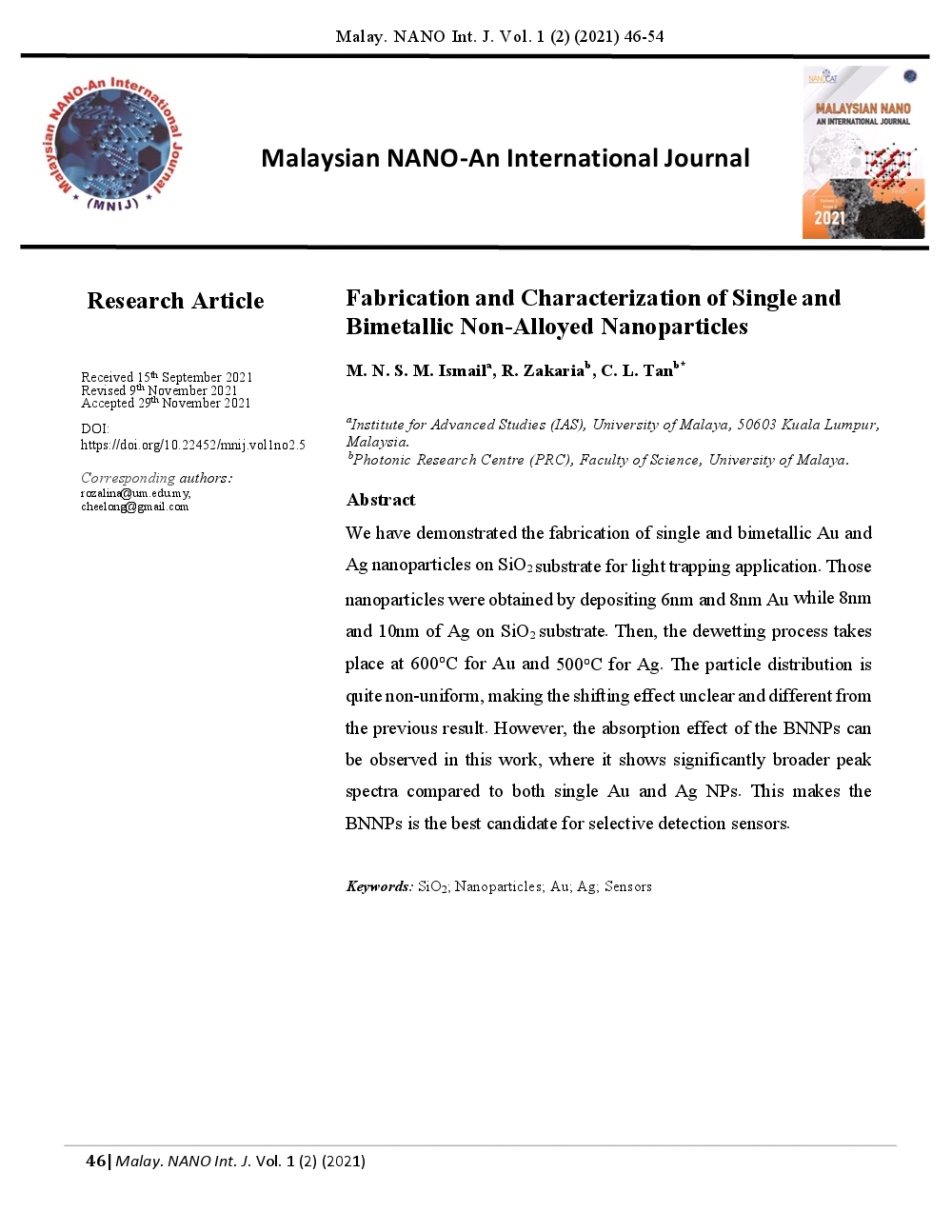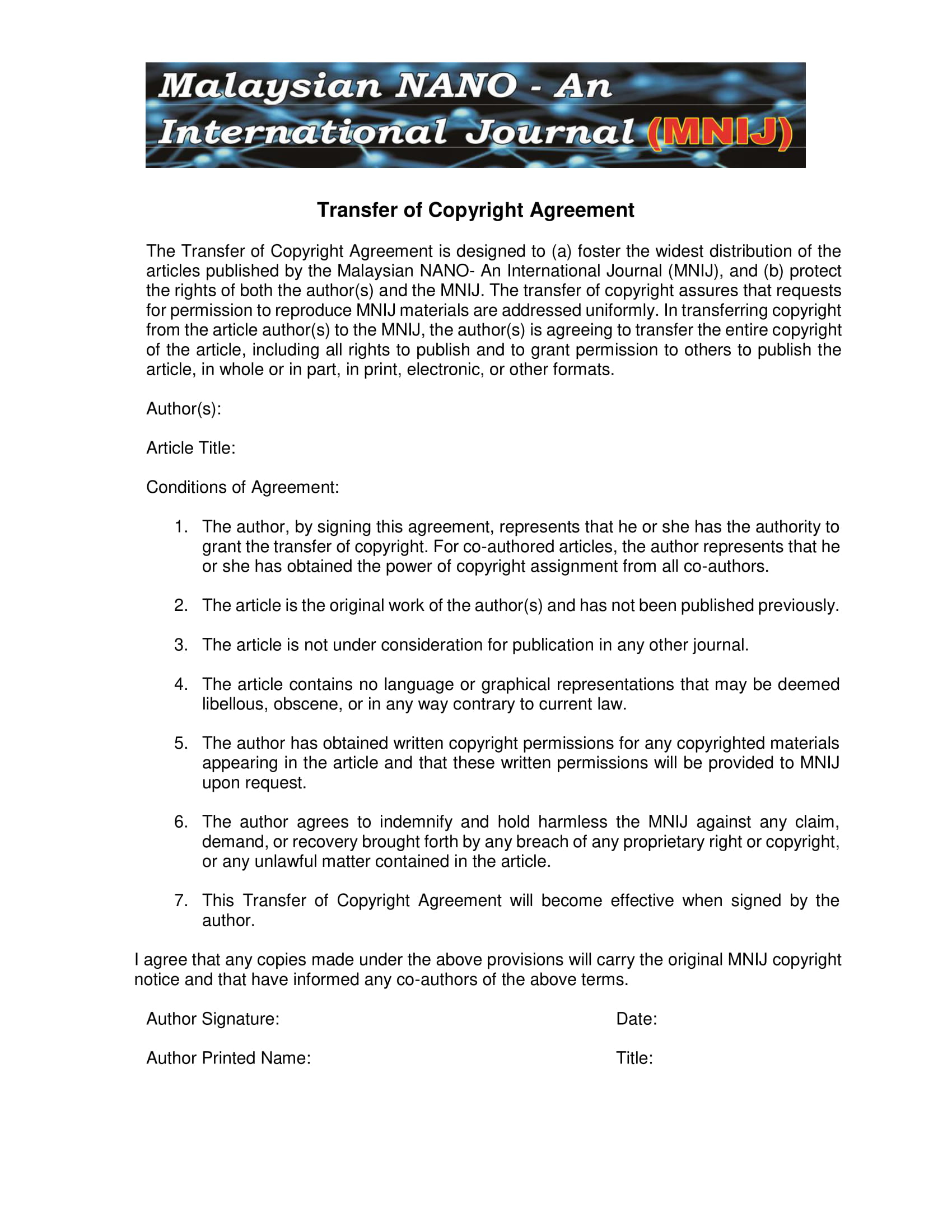Fabrication and characterization of single and bimetallic non-alloyed nanoparticles
DOI:
https://doi.org/10.22452/mnij.vol1no2.5Keywords:
SiO2, Nanoparticles, Au, Ag, SensorsAbstract
We have demonstrated the fabrication of single and bimetallic Au and Ag nanoparticles on SiO2 substrate for light trapping application. Those nanoparticles were obtained by depositing 6nm and 8nm Au while 8nm and 10nm of Ag on SiO2 substrate. Then, the dewetting process takes place at 600oC for Au and 500oC for Ag. The particle distribution is quite non-uniform, making the shifting effect unclear and different from the previous result. However, the absorption effect of the BNNPs can be observed in this work, where it shows significantly broader peak spectra compared to both single Au and Ag NPs. This makes the BNNPs is the best candidate for selective detection sensors.
Downloads
References
R.F. Aroca. Plasmon-enhanced spectroscopy. Physical Chemistry Chemical Physics. 2013.
S. Basu, S.K. Ghosh, S. Kundu, S. Panigrahi, S. Praharaj, S. Pande, T. Pal. Biomolecule induced nanoparticle aggregation: Effect of particle size on interparticle coupling. Journal of Colloid and Interface Science. 2017: 313;2; 724–734.
F. Canfarotta, M.J. Whitcombe, & S.A. Piletsky. Polymeric nanoparticles for optical sensing. Biotechnology Advances. 2013: 31;8; 1585–1599.
J. Chen, W. Tang, B. Tian, B. Liu, X. Zhao, Y. Liu, K.P. Loh. Chemical Vapor Deposition of High-Quality Large-Sized MoS2Crystals on Silicon Dioxide Substrates. Advanced Science. 2016: 3;8; 1–7.
C. Clavero. Plasmon-induced hot-electron generation at nanoparticle/metal-oxide interfaces for photovoltaic and photocatalytic devices. Nature Photonics. 2014: 8;2; 95–103.
S.K. Ghosh & T. Pal. Interparticle coupling effect on the surface plasmon resonance of gold nanoparticles: From theory to applications. Chemical Reviews. 2007: 107;11; 4797–4862.
K.S. Lee & M.A. El-Sayed. (2006). Gold and silver nanoparticles in sensing and imaging: Sensitivity of plasmon response to size, shape, and metal composition. Journal of Physical Chemistry B. 2006: 110; 39; 19220–19225.
T. Loewenstein, A. Hastall, M. Mingebach, Y. Zimmermann, A. Neudeck, & D. Schlettwein. Textile electrodes as substrates for the electrodeposition of porous ZnO. Physical Chemistry Chemical Physics. 2008: 10;14; 1844–1847.
M. Nayeri, M. Moradinasab, & M. Fathipour. The transport and optical sensing properties of MoS2, MoSe2, WS2, and WSe2 semiconducting transition metal dichalcogenides. Semiconductor Science and Technology. 2018: 33;2.
A.L. Rogach.Nanocrystalline CdTe and CdTe(S) particles: Wet chemical preparation, size- dependent optical properties, and perspectives of optoelectronic applications. Materials Science and Engineering B. 2000: 69; 435–440.
C.L. Tan, S.K Lee, & Y.T. Lee. Bi-SERS sensing and enhancement by Au-Ag bimetallic non- alloyed nanoparticles on an amorphous and crystalline silicon substrate. Optics Express. 2015: 23;5; 6254.
P. Wang, B. Huang, Y. Dai & M.H. Whangbo. (2015). Plasmonic Photocatalysts: Harvesting Visible Light with Noble Metal Nanoparticles. Physical Chemistry Chemical Physics. 2015:3:201890; 10715– 10722.
M.D. Ward & A.J. Bard. (1982). Photocurrent enhancement via trapping of photogenerated electrons of TiO2 particles. Journal of
M. N. S. M. Ismail et al (MNIJ) Issue 2 (2021) 46-54
Y. Yang, J. Shi, G. Kawamura & M. Nogami. (2008). Preparation of Au-Ag, Ag-Au core- shell bimetallic nanoparticles for surface-enhanced Raman scattering. Scripta Materialia. 2008: 58;10; 862– 865.

Downloads
Published
How to Cite
Issue
Section
License





